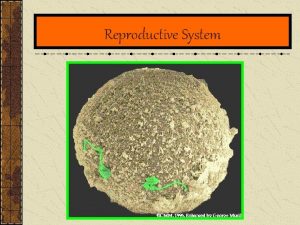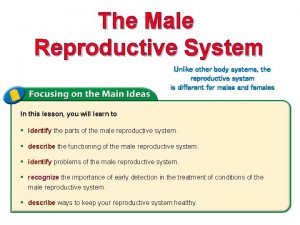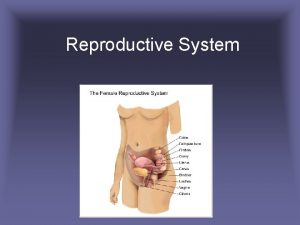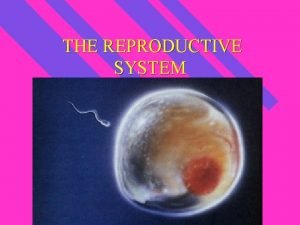Reproductive System Reproductive System The Reproductive System unlike





























































































- Slides: 93

Reproductive System

Reproductive System The Reproductive System, unlike other systems we have studied, is not essential to the survival of an individual. Organisms can survive and lead healthy lives without reproducing. What the reproductive system is important to is the survival of the species. Reproduction is absolutely essential to the continuation of the species…some of us must reproduce.

Gonads? ? ? Yeah. . it a real word with real meaning Gonads…are actually testes and ovaries. They are endocrine glands that secrete sex hormones. The primary function of gonads is not to produce hormones but to produce and store gametes—sperm and egg.

Reproduction In humans the reproductive system produces, stores, nourishes, and releases specialized sex cell known as Gametes. The ways in which the Gametes are released make possible the fusion of Sperm (Male Gametes) and Egg (Female Gametes) in the process of Fertilization. From a fertilized egg, or Zygote, come all the cells in a human body

Reproduction 1. For the first six weeks after fertilization, human male and female embryos are identical in appearance. 2. During the seventh week of development, major changes occur:

Reproduction A. The Testes, which are the primary reproductive organs of a male, begin to produce Steroid Hormones (Sex) known as Androgens. The tissue of the embryo responds to these hormones by developing into the Male reproductive organs. B. The Ovaries, or the primary reproductive organs of a female. They produce steroid hormones (Sex) known as Estrogens. The tissue of the embryo responds developing female reproductive organs.

Reproduction The male and female reproductive organs develop from exactly the same tissue in the embryo. After birth the Testes and the Ovaries continue to produce small amounts of Sex Hormones. These Sex Hormones continue to influence the development of the reproductive organs. Neither Testes or Ovaries are capable of producing active reproductive cells (Gametes) until Puberty.

Puberty- is a period of rapid growth and sexual maturation during which the reproductive system becomes fully functional. At the completion of puberty, the male and female gonads, or reproductive organs, are fully developed. The onset of puberty varies among individuals. It may occur anytime between the ages of 9 -15 Generally begins a year early in females.

Puberty begins with a change in the hypothalamus, the part of the brain that regulates the secretions of the pituitary gland This changes causes the pituitary gland to produce increased levels of two hormones that affect the gonads: A. Follicle Stimulating Hormone (FSH) B. Luteinizing Hormone (LH)

Male Reproductive System The male gonads help in production and storage of sperm and the to prepare sperm for the possible fertilization of an egg Males begin to produce Sperm during Puberty, the adolescent stage of development when changes in the body make reproduction possible. At this time, the concentration of the hormone Testosterone is high enough to stimulate sperm production. Testosterone is the Main Androgen (Male Sex Hormone) produced by the Testes

Male Reproductive System The Testes develop within the abdominal cavity, just before birth the testes descend through a canal into an external sac called the Scrotum.

Male Reproductive System The Testes (two eggshaped structures) remain in the Scrotum, outside the body. The temperature is about 3 degrees C Cooler than the body internal temperature (27 degrees C). Sperm development in the testes requires the lower temperature.

Male Reproductive System The Testes are clusters of hundreds of tiny tubules called Seminiferous (sehm-uh-NIHF-er-uhs) Tubules, which means "Seed Bearing". In total over 200 meter of seminiferous tubules. Sperm form through meiosis in the specialized lining of this extensive network of tubules.

Male Reproductive System As the pituitary gland begins to release FSH and LH, these hormones stimulate the testes to make the principal male sex hormone Testosterone produces a number of secondary sex characteristics that appear in males at puberty Voice Deepens Beard Grows Body Hair.

Male Reproductive System FSH and Testosterone stimulate the development of Sperm. When large numbers of sperm have been produced in the Testes, the development process of Puberty is completed - The male reproductive system is now functional. .

Sperm Development Sperm are derived from Special Cells within the Testes that go through the process of Meiosis to form haploid nuclei found in Mature Sperm. The Chromosome number drops from 46 to 23. Four sperm cells result from each cell that begins meiosis. This process is called spermatogenesis

Sperm Development A Mature Sperm consists of three Regions: (Figure 52 -1) HEAD - which contains the Nucleus (The 23 Chromosomes) and enzymes that help the sperm penetrate the protective layers that surround and Egg Cell. MID PIECE - packed with energy releasing Mitochondria (Energy Source). The Mitochondria supply the energy that is required for sperm to reach an Egg. TAIL – Consists of a Single, Powerful flagellum that propels the Sperm.


Sperm Development Developed Sperm travel from the Seminiferous Tubules ( in the testes) into the Epididymis. The Epididymis function is to nourish immature sperm cells, promote their growth, and gain their ability to swim as it flagellum completes development.

Sperm Development Although most sperm remain stored in each epididymis, some leave the epididymis and pass into through the Vas Deferens, a duct that extends from the epididymis into the abdominal cavity, where it loops around the urinary bladder and merges with the urethra. In a male, both urine and sperm exit the body through the urethra

Sperm Development In the urethra, sperm mix with Fluids that are secreted by 3 other glands- (Seminal Vesicles, Bulbourethral Glands, and the Prostate Gland) to produce Seminal fluid which protects and nourishes the sperm. The combination of sperm and seminal fluid is known Semen

Sperm Development Between 100 and 200 million sperm are present in 1 milliliter of semen or about 5 million sperm per drop.

Sperm Development The Vas Deferens merges with the Urethra, the tube that leads to the outside of the body through the penis. Sperm are ejected from the penis by contractions of smooth muscles lining the Vas Deferens. This process is called ejaculation. The function of the penis is to convey urine and semen.


Sperm 300 - 400 million Sperm are released in the reproductive tract of a female during a single ejaculation; The chances of a single sperm fertilizing and egg, if one is available, are quit Good. Most sperm are killed by the Acidic environment of the female reproductive track. Only a few sperm reach the site of fertilization.


Sperm Development Remember…. Sperm make up only 10 Percent of Semen, 90 percent is the fluid secreted by the Three Glands.

Female Reproduction The female gonads-ovaries-are endocrine glands that produce gametes. The female reproductive system prepares the female gametes-eggs-for possible fertilization. It also contains structures that enable fertilization to occur and that house and nourish a developing baby.

Female Reproduction The primary reproductive organs of the female are the OVARIES. The Ovaries are located in the lower abdominal cavity The Ovaries usually produce only one egg or ovum per month. The production of egg through meiosis is called Oogenesis. In addition to producing eggs, the female reproductive system has another important job to perform … Each time an egg is released the body must be prepared to nourish a developing embryo.

Female Reproduction Puberty in females starts with changes in the hypothalamus that causes the release of FSH and LH from the pituitary gland. FSH (follicle stimulating hormone) stimulates cells within the ovaries to produce the hormone Estrogen causes the reproductive system to complete its development Also produce secondary sex characteristics – Enlargement of Breast and Reproductive Organs. Widening of the Hips Growth of Body Hair.

Egg Development Each ovary contains about 400, 000 primary follicles, which are clusters of cells surrounding a single ovum (egg). During her lifetime fewer than 500 Ova (Eggs) will actually be released, averaging one egg about every 28 days. A female is actually born with ALL of her immature eggs. They don’t become active until puberty. The function of a follicle is to prepare a single ovum for release into the part of reproductive system where it can be fertilized. Ova mature within their follicles. The maturing eggs become large, highly complex cells, growing nearly 75, 000 times Larger than Sperm.

Egg Development When a follicle has completely matured, the Ovum (Egg) is released. This process is called Ovulation. If two eggs mature, fraternal, or non identical twins may result. Ovulation begins at puberty and usually continues until a female is in her late forties, when menopause occurs. After menopause, follicle development no longer occurs and a female is no longer capable of bearing children. (Biological Clock)

OOgenesis Gamete production in males begins at puberty and continues throughout life, but the situation is quite different in females. It has been assumed that a female’s total supply of eggs is already determined by the time she is born, and the time span during which she releases them extends from puberty to menopause. Approximately 250, 000 eggs are available at the beginning stage of puberty but only about 400 -500 are used between puberty and menopause.

OOgenesis Meiosis occurs in testes in the males and the ovaries in females. Female sex cells are produced and the process is called oogenesis. The process can be very complicated so I have tried to simplify it. The process of meiosis actually begins prior to birth but is stalled in Prophase I (called a primary oocyte) until puberty. In puberty it will begin again one each month, Meiosis I will be complete forming what is called a (first) polar body and secondary oocyte.

OOgenesis The (first) polar body is not functioning. It may or may NOT undergo Meiosis II producing two polar bodies that will degenerate. In humans the secondary oocyte will begin Meiosis II continue through to Metaphase II and then pause. This is where fertilization will occur. If it is NOT penetrated by a sperm it simply degenerates. If fertilization does occur it quickly completes meiosis II yielding one large ovum and a tiny secondary polar body.

OOgenesis The end products of oogenesis are three tiny polar bodies, nearly devoid of cytoplasm, and one large ovum. Key difference in males…all 4 gametes are functional. The unequal cytoplasmic division that occur during oogenesis ensure that a fertilized egg has ample nutrients for its six to seven day journey to the uterus. Without the cytoplasm the polar bodies degenerate and die.

Oogenesis

Female Reproduction The follicle literally ruptures, and the ovum is swept from the ovary into one of the two Fallopian tubes. The Fallopian Tubes provide a way for an egg to travel from the ovary to the uterus. The Ovum (egg) is moved through the fluid filled Fallopian tubes by cilia attached to the cells that line the walls of the tube. The fallopian tubes are approximately 4 inches long.

Female Reproduction It is during its journey through the fallopian tube that an egg can be fertilized. An egg must be fertilized within 48 hours of its release - after that, the egg begins to break down. Unfertilized eggs dissolve in the Uterus.

Female Reproduction The fact that the uterine tubes (fallopian) are not continuous with the ovaries places women at risk for ectopic pregnancy. This is where the zygote or fertilized egg actually begins to develop in the uterine tube. Because of the obvious lack of adequate mass and vascularization to support a full term pregnancy, such pregnancies naturally abort and usually with substantial bleeding.


Female Reproduction q After a few days, the ovum passes from the fallopian tube into the Uterus. q The lining of the uterus is specially designed to receive a fertilized ovum. q The uterus (Latin for womb)- is located in the pelvis, it is a hollow, thick-walled, muscular organ that functions to receive, retain, and nourish a fertilized ovum. Here the blastocytes is finding a place to attach on the uterine wall.

Female Reproduction q In a never before pregnant woman the uterus is about the shape of a pear…usually grows larger with each additional pregnancy. q The major portion of the uterus is called the body, the rounded superior region is called the fundus, and the region between the body and the cervix is called the isthmus. q After delivery nurses will do what is called a “fundus check”, they will press on your stomach (which is painful) to help you uterus return to its original shape.

Female Reproduction q. The wall of the uterus is made of three layers. q. Perimetrium (outer most layer) q. Myometrium (middle layer) q. Endometrium (inner most layer)

Female Reproduction q If fertilization occurs the young embryo burrows into the endometrium (implants) and resides there for the rest of its development. q The enodmetrium is highly vascular and supplies the embryo with nutrients throughout pregnancy. q If fertilization fails to occur the egg is discarded along with the lining (which is shed monthly) of the endomentrium.

Female Reproductive System

Female Reproduction The lower entrance to the uterus is called the Cervix. A sphincter muscle in the cervix controls the opening to the uterus. The cervix contains cervical glands that secrete a mucus that fills the cervical canal. The mucus blocks bacteria from the vagina into the cervix as well as blocking the entry of sperm except during mid-cycle where it becomes less viscous and allows sperm to pass through.

Female Reproduction Cancer of the cervix strikes a bout 450, 000 women worldwide each year, killing about half. Affects women between the ages of 30 -50 The cancer cells arise from the epithelium covering the cervical tip. Risk that increase the chances of cervical cancer are frequent cervical inflammation, sexually transmitted diseases and partners, and multiple pregnancies. How do you find out if you have cervical cancer? ?

Pap Smear Papanicolaou (pap) smear- (cervical smear) is a test in which a speculum is inserted in the vagina and a tiny sample of cervical tissue is scraped off. This sample is smeared on a glass slide and send to a lab where a cytotechnologists stains and examines it for the presence of abnormal cells which may indicated cervical cancer. Pap smears should be begin as soon as the female becomes sexual active and should last until the age of 70. Pap Smears are the most effective way to determine cervical cancer.

Pap Smear

normal cervical cells

Abnormal cervical cells

Female Reproduction The cervix is what dilates during labor and delivery. The scale that is used ranges from 1 -10.

Female Reproduction Leading from the cervix is a muscular tube called the Vagina or Birth Canal. This organ connects the uterus to the body’s exterior.

Female Reproduction The vagina provides the following: Passageway for delivery of an infant Passageway for menstrual flow Receives the penis and semen during sexual intercourse.

Female Reproduction The external structures of the female Reproductive System are collectively called the Vulva. The Vulva includes the mons pubis, labia, clitoris, and structures associated with vestibule. Labia (majora and minora) – are the folds of skin and mucous membranes that cover and protect the opening to the female reproductive system. The Clitoris corresponds to the male penis and is composed of two columns of erectile tissue

Female Reproduction

Menstrual Cycle In females, the interaction of the reproductive system and the endocrine system takes the form of a complex series of periodic events called the Menstrual Cycle. The Cycle takes an average of about 28 days. This in itself can get extremely complicated so because we are pressed for time I am just going to give you a very short version.

Menstrual Cycle Each month the female body prepares as if it going to receive and nourish an Embryo. The hormones (estrogen and progestrogen) the body release cause the lining of the Uterus to become extremely thick…this would house the future zygote if need be. If there is no sperm to fertilized the egg then a decrease in levels of estrogen and progesterone caused the blood vessels in the uterine lining to begin closing and then break.

Menstrual Cycle The mixture of blood and the cells that made up the lining of the uterus is called Menstrual Fluid The passage of this fluid through the vagina and out of the body is called Menstrulation or the Menstrual Period. (this can last from 3 -7 days)

Mammary Glands The mammary glands are present in both sexes, but they normally functions only in females. The biological role of the mammary glands is to produce milk to nourish a newborn baby. Developmentally mammary glands are part of the skin or integumentary system.

Mammary Glands Each mammary gland is contained within a rounded skin colored breast. Below the center of each breast is a ring of pigmented skin the areola which surrounds a central protruding nipple.

Sexually Transmitted Diseases STD’s-(also called venereal diseases)-are infectious diseases spread through sexual contact. The US has the highest rate of infection among developed countries. Over 12 million people in the US get an STD each year. (Over 4 million are adolescents)

Sexually Transmitted Diseases STD are the single most important cause of reproductive disorders. For years gonorrhea and syphilis lead the way as the most common STD’s. In recent years, AIDS has taken center stage.

Gonorrhea THE FACTS Gonorrhea (gon a REE a) is a sexually transmitted disease (STD). Caused by bacteria called Neisseria gonorrhoeae …which invades the mucosa of the reproductive and urinary tracts. Anyone who is sexually active can get gonorrhea. It is more common among teens and young adults. Many people who have gonorrhea don’t know it. Especially in women, the disease often has no symptoms. You can pass gonorrhea to others without knowing it. Gonorrhea is easy to treat and cure. If you do not treat gonorrhea, it can lead to serious health problems. Commonly called “the clap”

Gonorrhea- How do you get it? You can get gonorrhea by having sex with someone who has it. "Having sex" means having anal, or vaginal contact. If you are a pregnant woman who has gonorrhea, you can pass the infection to your baby.

Gonorrhea- Symptoms IF YOU ARE A WOMAN You can get gonorrhea in the anus, eyes, mouth, throat, urinary tract, or uterus. You may notice any symptoms. If you do have symptoms, they will vary depending on what part of your body is infected. If you have gonorrhea in the uterus or urinary tract, you might notice these symptoms: Vaginal bleeding between your periods. Pain or burning when you pass urine. Increased vaginal discharge. If you have gonorrhea in the rectum, you might notice these symptoms: Itching, soreness, bleeding, a discharge from your rectum, or painful bowel movements. If you have gonorrhea in the throat, you might notice that your throat is sore.

Gonorrhea- Symptoms IF YOU ARE A MAN If you do have symptoms, they will vary depending on what part of your body is infected. If you have gonorrhea in the penis, you might notice these symptoms: Pain or burning when you pass urine. A discharge from your penis. Painful or swollen testicles. If you have gonorrhea in the rectum, you might notice: Itching, soreness, bleeding, a discharge from your rectum, or painful bowel movements. If you have gonorrhea in the throat, you might notice that your throat is sore.

Gonorrhea- Treatments Gonorrhea can be treated and cured with antibiotics. Finish all of the medicine to be sure you are cured. Don’t share your medicine with anyone. You need all of it. If you still have symptoms after treatment, go back to see the doctor.

Gonorrhea

Syphilis is a sexually transmitted disease (STD) caused by the bacterium Treponema pallidum. It has often been called “the great imitator” because so many of the signs and symptoms are indistinguishable from those of other diseases.

Syphilis is passed from person to person through direct contact with a syphilis sore. Sores occur mainly on the external genitals, vagina, anus, or in the rectum. Sores also can occur on the lips and in the mouth. Transmission of the organism occurs during vaginal, anal, or oral sex. Pregnant women with the disease can pass it to the babies they are carrying. Syphilis cannot be spread through contact with toilet seats, doorknobs, swimming pools, hot tubs, bathtubs, shared clothing, or eating utensils.

Syphilis Symptoms Many people infected with syphilis do not have any symptoms for years. Although transmission occurs from persons with sores who are in the primary or secondary stage, many of these sores are unrecognized. Thus, transmission may occur from persons who are unaware of their infection.

Syphilis Symptoms SYMPTOMS-Primary Red, painless primary lesions called chancre appear. These appear on the penis of males. Females often unnoticed within the vagina or on the cervix. These often heal and go away. Symptoms- Secondary If syphilis is untreated, secondary signs appear several weeks later. Pink rash all over body Fever and joint pain These will appear and disappear for many weeks. Syphilis can go into a latent period where it is only detectable through a blood test!

Syphilis- treatment Treatment As with Gonorrhea…. antibiotics are used a a treatment.

Syphilis

Chlamydia is a common sexually transmitted disease (STD) caused by the bacterium, Chlamydia trachomatis, which can damage a woman's reproductive organs. Even though symptoms of chlamydia are usually mild or absent, serious complications that cause irreversible damage, including infertility, can occur "silently" before a woman ever recognizes a problem. Chlamydia can be transmitted during vaginal, anal, or oral sex. Chlamydia can also be passed from an infected mother to her baby during vaginal childbirth.

Chlamydia Is a largely undiagnosed, silent epidemic that infects perhaps 4 -5 millions people yearly, making it the most common bacterial sexually transmitted disease in the US Responsible for 20 -50% of inflammatory disease Also caused by Also responsible for 25% of ectopic pregnancies.

Chlamydia Symptoms- painful and frequent urination Thick penile and vaginal discharge Abdominal, rectal, or testicular pain Painful intercourse Irregular menses Urogenital tract infection in men. Symptoms- 80% of women can have NO symptoms Leading causes of sterility. Newborns can be infected in the birth canal.

Chlamydia can be easily treated and cured with antibiotics.

HPV Genital human papillomavirus (/pap pil LO ma VY rus/)(HPV) is the most common sexually transmitted virus in the United States. At least 50% of sexually active people will have genital HPV at some time in their lives. Most people who have genital HPV don’t know they have it. There are often no symptoms, and it goes away on its own—without causing any serious health problems. HPV is passed on through genital contact (such as vaginal and anal sex). You can pass HPV to others without knowing it. There is no cure for HPV, but there are treatments for the health problems that some types of HPV can cause, like genital warts and cervical cancer.

HPV Anyone who has ever had genital contact with another person can have genital HPV. Both men and women can get it - and pass it on - without even realizing it Genital HPV does not cause health problems for most people.

HPV- Genital Warts All HPV infections are either low-risk or high-risk. Low-risk HPV infections can cause genital warts. The warts are usually painless and not a serious problem. They can be flat or raised, single or in groups, and small or large. Without treatment, the warts may grow in size and number, or they may go away on their own. Women with HPV might have warts on the vagina, vulva, or cervix. Men with HPV might have warts on the penis, scrotum, or groin. Both men and women can have genital warts on the anus or thigh.

HPV- Genital Warts

HPV- Cervical Cancer High-risk HPV infections can sometimes develop into cancer of the cervix (the opening of the womb). These infections may also lead to other cancers, such as anal cancer. In some people, high-risk HPV infections can persist and cause cell changes. If these cell changes are not treated, they may lead to cancer over time. It’s important to know about the link between genital HPV and cervical cancer and about the steps you can take to prevent this disease. Cervical cancer can be prevented with regular Pap tests and follow-up. Pap tests can find problems in the cervix that are caused by HPV.

HPV- Do I need to know? ? ? There is no reason to be tested just to find out if you have genital HPV. Most people will have genital HPV at some time in their lives. Usually the infection goes away on its own. However, it is very important for women to get screened for cervical cancer that is caused by genital HPV. There is no treatment for genital HPV itself. Most of the time, though, your body fights off the virus on its own There are treatments for the health problems that genital HPV can cause, like genital warts, cervical changes, and cervical cancer. Even after genital warts are treated, the virus may remain in the body. This means that you may still pass HPV to your sex partners.

HPV- Vaccine? The FDA has approved a vaccine that protects against four types of HPV. Together, these four types of HPV cause 7 out of 10 cases of cervical cancer and 9 out of 10 cases of genital warts. Experts on vaccines have recommended that all girls should get the vaccine when they are 11 or 12 years old. Girls and women between 13 and 26 years old can also benefit from the vaccine. The vaccine is most effective in girls and women who have not been infected with any of the four types of HPV that the vaccine protects against. This is the reason the experts recommend that it be given to young girls before they become sexually active.

Genital Herpes Genital herpes is a sexually transmitted disease (STD) caused by the herpes simplex viruses type 1 (HSV-1) or type 2 (HSV-2). Most genital herpes is caused by HSV-2. Most individuals have no or only minimal signs or symptoms from HSV-1 or HSV-2 infection. When signs do occur, they typically appear as one or more blisters on or around the genitals or rectum. The blisters break, leaving tender ulcers (sores) that may take two to four weeks to heal the first time they occur. Typically, another outbreak can appear weeks or months after the first, but it almost always is less severe and shorter than the first outbreak. Although the infection can stay in the body indefinitely, the number of outbreaks tends to decrease over a period of years.

Genital Herpes At least 45 million people ages 12 and older, or one out of five adolescents and adults, have had genital HSV infection. Genital HSV-2 infection is more common in women (approximately one out of four women) than in men (almost one out of eight). This may be due to maleto-female transmission being more likely than female-to-male transmission.

Genital Herpes Regardless of severity of symptoms, genital herpes frequently causes psychological distress in people who know they are infected. In addition, genital HSV can lead to potentially fatal infections in babies. If a woman has active genital herpes at delivery, a cesarean delivery is usually performed. Herpes may play a role in the spread of HIV, the virus that causes AIDS. Herpes can make people more susceptible to HIV infection, and it can make HIV-infected individuals more infectious.

Genital Herpes There is no treatment that can cure herpes, but antiviral medications can shorten and prevent outbreaks during the period of time the person takes the medication. In addition, daily suppressive therapy for symptomatic herpes can reduce transmission to partners.

Genital Herpes

Condoms…do they work? Condoms and STDs: Fact Sheet FACT: The best way to avoid an STD is to abstain from any form of sexual activity. Latex condoms, when used consistently and correctly, are highly effective in preventing the sexual transmission of HIV, the virus that causes AIDS. In addition, consistent and correct use of latex condoms reduces the risk of other sexually transmitted diseases (STDs), including diseases transmitted by genital secretions, and to a lesser degree, genital ulcer diseases. Condom use may reduce the risk for genital human papillomavirus (HPV) infection and HPVassociated diseases, e. g. , genital warts and cervical cancer.
 Examples of like parallel forces and unlike parallel forces
Examples of like parallel forces and unlike parallel forces Hình ảnh bộ gõ cơ thể búng tay
Hình ảnh bộ gõ cơ thể búng tay Frameset trong html5
Frameset trong html5 Bổ thể
Bổ thể Tỉ lệ cơ thể trẻ em
Tỉ lệ cơ thể trẻ em Gấu đi như thế nào
Gấu đi như thế nào Tư thế worm breton
Tư thế worm breton Chúa yêu trần thế alleluia
Chúa yêu trần thế alleluia Các môn thể thao bắt đầu bằng tiếng chạy
Các môn thể thao bắt đầu bằng tiếng chạy Thế nào là hệ số cao nhất
Thế nào là hệ số cao nhất Các châu lục và đại dương trên thế giới
Các châu lục và đại dương trên thế giới Công thức tính thế năng
Công thức tính thế năng Trời xanh đây là của chúng ta thể thơ
Trời xanh đây là của chúng ta thể thơ Mật thư tọa độ 5x5
Mật thư tọa độ 5x5 101012 bằng
101012 bằng độ dài liên kết
độ dài liên kết Các châu lục và đại dương trên thế giới
Các châu lục và đại dương trên thế giới Thể thơ truyền thống
Thể thơ truyền thống Quá trình desamine hóa có thể tạo ra
Quá trình desamine hóa có thể tạo ra Một số thể thơ truyền thống
Một số thể thơ truyền thống Bàn tay mà dây bẩn
Bàn tay mà dây bẩn Vẽ hình chiếu vuông góc của vật thể sau
Vẽ hình chiếu vuông góc của vật thể sau Thế nào là sự mỏi cơ
Thế nào là sự mỏi cơ đặc điểm cơ thể của người tối cổ
đặc điểm cơ thể của người tối cổ Thế nào là giọng cùng tên? *
Thế nào là giọng cùng tên? * Vẽ hình chiếu đứng bằng cạnh của vật thể
Vẽ hình chiếu đứng bằng cạnh của vật thể Tia chieu sa te
Tia chieu sa te Thẻ vin
Thẻ vin đại từ thay thế
đại từ thay thế điện thế nghỉ
điện thế nghỉ Tư thế ngồi viết
Tư thế ngồi viết Diễn thế sinh thái là
Diễn thế sinh thái là Dạng đột biến một nhiễm là
Dạng đột biến một nhiễm là Thế nào là số nguyên tố
Thế nào là số nguyên tố Tư thế ngồi viết
Tư thế ngồi viết Lời thề hippocrates
Lời thề hippocrates Thiếu nhi thế giới liên hoan
Thiếu nhi thế giới liên hoan ưu thế lai là gì
ưu thế lai là gì Khi nào hổ con có thể sống độc lập
Khi nào hổ con có thể sống độc lập Khi nào hổ con có thể sống độc lập
Khi nào hổ con có thể sống độc lập Hệ hô hấp
Hệ hô hấp Từ ngữ thể hiện lòng nhân hậu
Từ ngữ thể hiện lòng nhân hậu Thế nào là mạng điện lắp đặt kiểu nổi
Thế nào là mạng điện lắp đặt kiểu nổi Ducts in female reproductive system
Ducts in female reproductive system Endocrine system and reproductive system
Endocrine system and reproductive system Https://m..com/watch?v=nqecciuc7jy
Https://m..com/watch?v=nqecciuc7jy Metaphor for boring
Metaphor for boring Unlike dnarna contains
Unlike dnarna contains Like terms and unlike terms in polynomials
Like terms and unlike terms in polynomials Hummingbirds are amazing little birds passage
Hummingbirds are amazing little birds passage Adding mixed fractions with unlike denominators
Adding mixed fractions with unlike denominators Figures of speech of the road not taken
Figures of speech of the road not taken Tower crane types
Tower crane types Addition radicals examples
Addition radicals examples Unlike photoautotrophs chemoautotrophs obtain energy
Unlike photoautotrophs chemoautotrophs obtain energy Characteristics of psychological assessment
Characteristics of psychological assessment Specialized software packages examples
Specialized software packages examples 5.nf.1
5.nf.1 Chef's salad is an example of a _____ salad.
Chef's salad is an example of a _____ salad. Unlike passive transport, active transport requires *
Unlike passive transport, active transport requires * Different types of unemployment
Different types of unemployment Anorexics are unlike bulimics in that they __________.
Anorexics are unlike bulimics in that they __________. Multiplying fractions guided notes
Multiplying fractions guided notes Unlike other characters in the play creon displays
Unlike other characters in the play creon displays You should not open a persuasive request with a question.
You should not open a persuasive request with a question. Unlike bryophytes, lycophytes
Unlike bryophytes, lycophytes How to compare unlike fractions
How to compare unlike fractions Kelvin rodolfo
Kelvin rodolfo How is the crucible unlike the salem witch trials?
How is the crucible unlike the salem witch trials? Fraction example
Fraction example Identifying like terms
Identifying like terms Lysogenic cycle animation
Lysogenic cycle animation Foil to hamlet
Foil to hamlet Unlike b. f. skinner, noam chomsky believes that children
Unlike b. f. skinner, noam chomsky believes that children Unlike amphibians reptiles
Unlike amphibians reptiles Male reproductive system from front
Male reproductive system from front Functions of reproductive system
Functions of reproductive system Female testes
Female testes Fetus reproductive system
Fetus reproductive system The reproductive system chapter 16
The reproductive system chapter 16 Exercise 42 anatomy of the reproductive system
Exercise 42 anatomy of the reproductive system Accessory structures of female reproductive system
Accessory structures of female reproductive system Oogenesis
Oogenesis Epilization
Epilization Epidiymitis
Epidiymitis Broad ligament
Broad ligament Reproductive system jeopardy
Reproductive system jeopardy Parts of male and female reproductive system
Parts of male and female reproductive system Figure 16-1 male reproductive system
Figure 16-1 male reproductive system Graham munson
Graham munson Luteinizing hormone in male reproductive system
Luteinizing hormone in male reproductive system Exterior and interior of an egg
Exterior and interior of an egg Human reproductive system
Human reproductive system Art-labeling activity: the male reproductive system, part 1
Art-labeling activity: the male reproductive system, part 1



















































































































